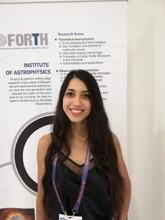PhD Thesis Defence Presentations - Christiana Genethliou

Abstract (Περίληψη)
Sanitary landfill leachate (SLL) is produced extensively in sanitary landfills and is loaded with hazardous substances, causing serious risks to both living organisms and the environment. In recent years, numerous processes, either single or combined, have been implemented to treat this hazardous wastewater. However, the treatment of raw leachate is very challenging due to the complexity of its composition. In almost all processes applied to treat raw landfill leachate, the quality of the final effluent did not fully comply with the discharge limits imposed by environmental regulations for release into a water body, while the combined systems developed consisted of mostly expensive processes.
The objective of the current PhD thesis is to treat real sanitary landfill leachates using single and combined processes, which are environmentally friendly, easy to operate, cost-effective and highly effective in removing pollutants from raw landfill leachate.
Initially, a naturally occurring zeolite was examined for the simultaneous removal of ammonium nitrogen (NH4+-N), dissolved chemical oxygen demand (d-COD) and color from raw SLL in batch adsorption (AD) experiments, where several operational parameters were applied. Saturation, desorption and regeneration tests of zeolite were performed. Mechanistic information for NH4+-N was also obtained by fitting adsorption/desorption data to kinetic and isotherm models using both linear and non-linear methods. Additional information regarding the assessment of the pathway of pollutants uptake was obtained by zeolite particles after adsorption, saturation, regeneration and desorption processes using scanning electron microscopy (SEM), powder X- ray diffraction (XRD) and X-ray photoelectron spectroscopy (XPS).
In a second stage, the efficiency of a naturally occurring palygorskite as an adsorbent for the simultaneous removal of color, d‐COD and NH4+-N from raw SLL was investigated. Operational parameters for adsorption process were also examined in batch adsorption experiments. Saturation and desorption studies of palygorskite were also performed for all three pollutants simultaneously. Natural palygorskite was then combined with natural zeolite in both single and sequential adsorption arrangements to evaluate possible enhancement of the treatment efficiency in terms of the simultaneous removal of color, d-COD and ΝΗ4+-Ν. After adsorption, saturation and desorption, the palygorskite solids were characterized using XRD, Fourier-transform infrared spectroscopy (FTIR), XPS, SEM, energy dispersive spectroscopy (EDS), measurements of BET specific surface area (SSA), and the zeta potential of the suspended particles.
Next, a parametric evaluation of the electrocoagulation (EC) process on raw SLL was performed to optimize the process. Then, hybrid systems consisting of EC and AD (with natural zeolite and/or natural palygorskite) were developed using the optimal conditions of both processes to effectively treat raw SLL. The efficiency of the systems was examined in terms of simultaneous removal of color, d-COD, nitrate nitrogen (NO3--N) and NH4+-N. In particular, the optimal arrangement of the combined EC and AD system using zeolite (ADzeo) was assessed by changing the sequence of the two processes. Then, AD process using palygorskite (ADpal) was integrated into the first or middle stage of the optimum hybrid EC and ADzeo system determined, thus resulting in the implementation of two more hybrid systems: ADpal-ADzeo-EC and ADzeo-ADpal-EC.
Lastly, the effectiveness of a three-stage pilot approach using adsorption (AD), electrocoagulation (EC) and biological (BIO) processes for the treatment of raw SLL was investigated. Initially, column adsorption experiments with natural zeolite were performed to examine the removal of toxic NH4+-N using different initial NH4+-N concentrations and recirculation flow rates. Two sequential treatment scenarios were then examined, i.e., AD-EC-BIO and AD-BIO-EC, to determine which achieved the highest removal of pollutants and leachate toxic potential based on Thamnocephalus platyurus bioassay.
Speakers Short CV (Σύντομο Βιογραφικό Ομιλητή)
Education:
2017 - ...: PhD in Chemical Engineering
Department of Chemical Engineering, University of Patras
PhD thesis: Treatment of sanitary landfill leachates
Supervisor: Professor Dimitris Vayenas, Department of Chemical Engineering, University of Patras
2015 - 2017: MSc in Green Chemistry and Clean Technologies
Department of Chemistry, University of Patras
Master's thesis: Biodegradation of olive mill wastewater phenolic compounds in thermophilic anaerobic digestion and assessment of their toxicity in digested effluents.
Supervisor: Professor Michael Kornaros, Department of Chemical Engineering, University of Patras
Grade: 9.83/10
2015 - ...: Diploma in Oenology
Department of Chemistry, University of Patras
2010 - 2014: BSc in Chemistry
Department of Chemistry, University of Patras
Bachelor thesis: Expression profiling of genes involved in the biogenesis and transport of miRNAs in lung cancer.
Supervisor: Professor Constantinos Stathopoulos, Department of Medicine, University of Patras
Grade: 7.21/10
Publications:
C. Genethliou, I. E. Triantaphyllidou, D. Chatzitheodorou, A. G. Tekerlekopoulou, D.V. Vayenas, Development of hybrid systems by integrating adsorption process with natural zeolite and/or palygorskite into the electrocoagulation treatment of sanitary landfill leachate. (Under preparation)
C. Genethliou, T. Tatoulis, N. Charalampous, S. Dailianis, A.G. Tekerlekopoulou, D.V. Vayenas, Treatment of raw sanitary landfill leachate using a hybrid pilot-scale system comprising adsorption, electrocoagulation and biological process, Journal of Environmental Managment. (Submitted)
C. Genethliou, C.V. Lazaratou, I.E. Triantaphyllidou, E. Xanthaki, N. Mourgkogiannis, L. Sygellou, A.G. Tekerlekopoulou, P. Koutsoukos, D.V. Vayenas, Adsorption studies using natural palygorskite for the treatment of real sanitary landfill leachate, J. Environ. Chem. Eng. 10 (2022) 108545. https://doi.org/10.1016/J.JECE.2022.108545
C. Genethliou, I.E. Triantaphyllidou, D. Giannakis, M. Papayianni, L. Sygellou, A.G. Tekerlekopoulou, P. Koutsoukos, D. V. Vayenas, Simultaneous removal of ammonium nitrogen, dissolved chemical oxygen demand and color from sanitary landfill leachate using natural zeolite, J. Hazard. Mater. 406 (2021) 124679. https://doi.org/10.1016/j.jhazmat.2020.124679
C. Genethliou, M. Kornaros, S. Dailianis, Biodegradation of olive mill wastewater phenolic compounds in a thermophilic anaerobic upflow packed bed reactor and assessment of their toxicity in digester effluents, J. Environ. Manage. 255 (2020). https://doi.org/10.1016/J.JENVMAN.2019.109882
Scholarships:
23.08.20-03.09.2020 European Forum Alpbach–Scholarship awarded by Elsevier
04.2019-12.2023 Hellenic State Scholarship Foundation (IKY)
01.2018-03.2019 Stavros Niarchos Foundation-FORTH/ICE-HT
2010-2013 Cyprus State Scholarship Foundation (IKYΚ)
Awards:
22-26.07.2019 3rd Poster Award to Genethliou C., Papayianni M., Giannakis D., Triantaphyllidou I.E., Tekerlekopoulou A., Vayenas D. for the e-poster entitled: “Removal of NH4+-N from sanitary landfill leachates using adsorption process” presented at the 5th Distance Education e-learning summer school on “Wastewater and Biosolids Management” (WWSS19), held in Patras, Greece.
